From red rock gardens and epic mountain parks to vibrant urban greenspaces and nature preserves, Colorado Springs parks capture the region’s incomparable natural beauty while providing ample room to play. The city’s park system encompasses over 15,000 acres collectively, giving visitors and residents alike seemingly endless outdoor escapes right in town.
| Park Name | Description |
|---|---|
| Garden of the Gods | Over 1,300 acres of red sandstone formations with hiking and biking trails. |
| Red Rock Canyon Open Space | 787 acres featuring red sandstone, conglomerate rock, and limestone cliffs with multi-use trails and rock climbing routes. |
| North Cheyenne Cañon Park | Over 1,800 acres near downtown with trails leading to waterfalls and historical sites. |
| Palmer Park | Nearly 1,300 acres of nature with multi-use trails, sandstone formations, and city views. |
| Pikes Peak Greenway Trail | A 12-mile cycling and walking path following Monument Creek with nature watching spots. |
| Bear Creek Regional Park and Nature Center | Over 1,200 acres with trails and wildlife exhibits, including a nature center. |
| Stratton Open Space | 766 acres of open space with trails for handcyclists, rollerbladers, and hikers. |
| Rock Ledge Ranch Historic Site | A living history museum depicting life from the 1880s-1900s with interactive exhibits. |
| Fountain Creek Regional Park | 520 acres centered around Fountain Creek with fishing, kayaking, and nature trails. |
| Fox Run Regional Park | 325 acres with a reservoir for boating, trails, and unique ecosystems. |
| Monument Valley Park | 160 acres along Monument Creek with walking paths, restored wetlands, and recreational facilities. |
The following top parks showcase Colorado Springs’ diverse landscapes, views and amenities available across its park network perfect for hiking, biking, picnicking, wildlife watching and beyond. They make enjoying the outdoors convenient no matter where your explorations take you.
Garden of the Gods
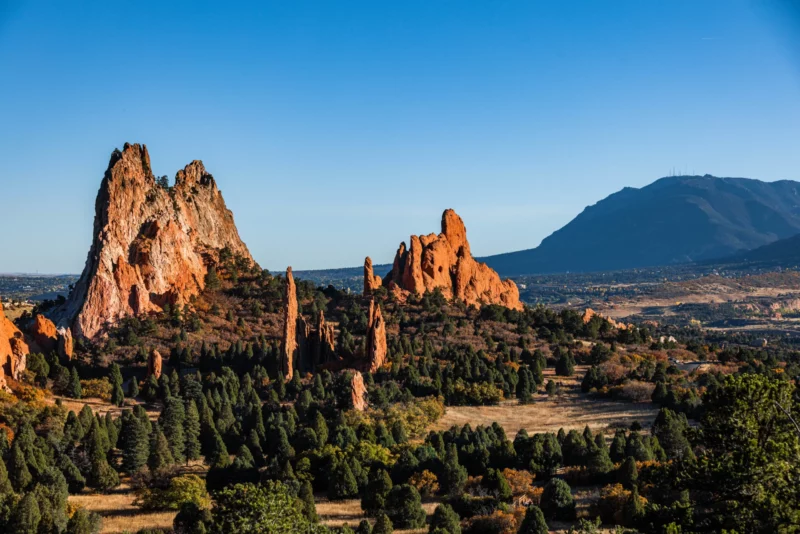
Name and Location: Garden of the Gods Park is located in Colorado Springs, spanning over 1,300 acres and framed by 300ft red sandstone rock formations, with Pikes Peak as a backdrop.
History and Significance: First established in 1879, this world-famous park protects unique sandstone features resembling castle parapets, balanced rocks and towering spires, framing picture-perfect views of Pikes Peak’s summit.
What to Expect: Visitors drive the loop road or hike easy trails to admire the park’s geological wonders rising sharply above Great Plains grasses. Designated rock climbing routes also ascend some formations. Interpretive programs occasionally offered.
Visitor Information: Garden of the Gods is open year-round daily from 5am-11pm. No admission fee. Rock Ledge Ranch section charges seasonal entry fee.
As the most visited attraction in the region, Garden of the Gods’ stunning red sandstone formations set against jagged Pikes Peak undoubtedly captivate. The free public park encompasses over 1,300 acres of otherworldly geological features like Balanced Rock and Kissing Camels just begging to be explored via hiking and biking trails from easy quarter-miles to intermediate 5-milers through the park’s heart.
With convenient access right off I-25, it’s easy to lose hours wandering through the unique scenery.
Red Rock Canyon Open Space
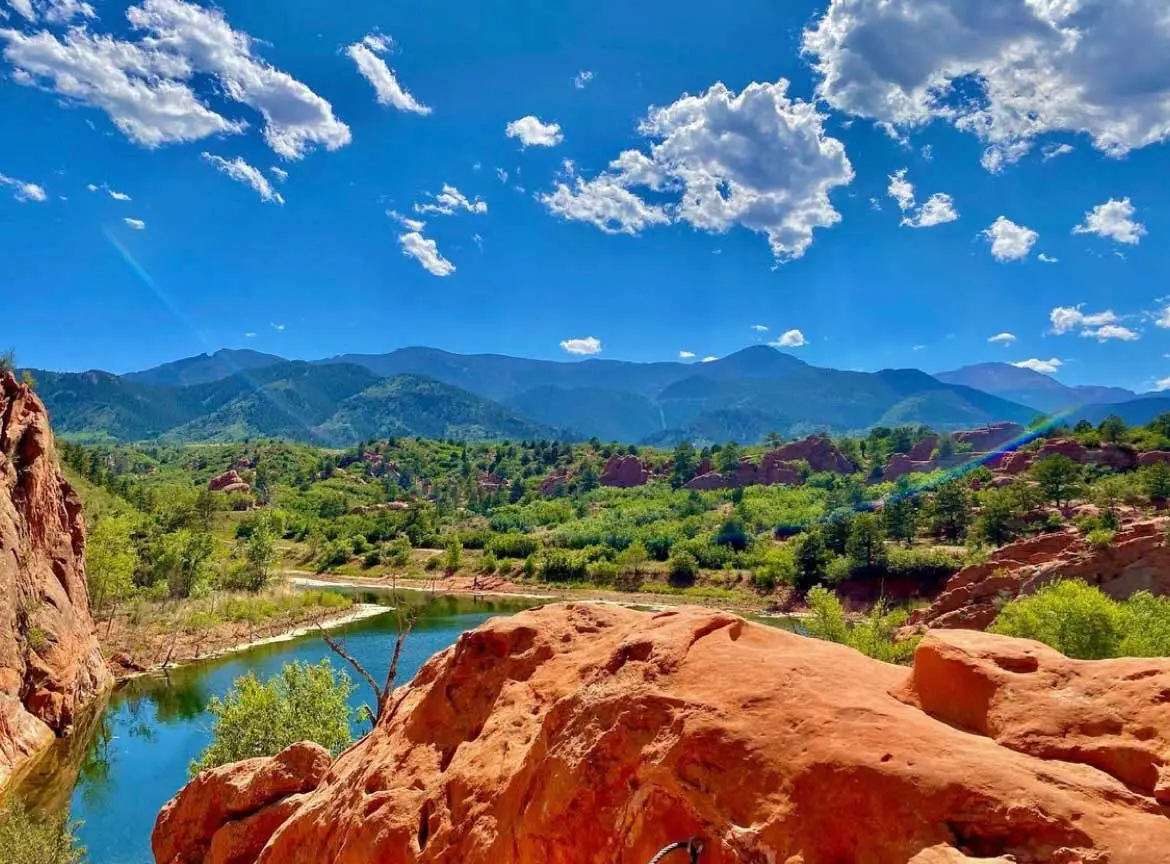
Name and Location: Red Rock Canyon Open Space contains a network of trails wrapping around red sandstone features in the rugged terrain west of Manitou Springs, Colorado.
History and Significance: Set aside for public recreation access in 2003 after prior ranching and mining uses, this 787-acre stretch of high desert landscape allows visitors to admire and explore the unique natural canyon environment via interpretive hiking and biking paths.
What to Expect: Trails range from easy to challenging navigating the rocky ridges and pinyon-juniper woodlands, unlocking panoramic valley vistas amid the rock formations and cliffs surrounding the region.
Visitor Information: Year-round trail use. Parking fee area with restrooms and displays at the Main Parking Lot. Pack water and sun protection.
Contrasting with adjacent Garden of the Gods, Red Rock Canyon Open Space presents southwestern style geology dominated by visibly vibrant red sandstone, conglomerate rock and limestone cliffs rather than thirty-foot tall monoliths. Eight miles of multi-use trails like Red Rock Rim with moderate inclines beckon along with rock climbing routes for enjoying the park’s 787 acres from every angle.
The Trading Post Trail even rewards with petroglyphs and million-year-old dinosaur tracks! With multiple access points, it’s a local hiking staple.
North Cheyenne Cañon Park

Name and Location: North Cheyenne Cañon Park encompasses over 1,600 acres of rugged natural landscape along the namesake canyon near downtown Colorado Springs, accessed from the Starsmore Center.
History and Significance: Acquired by the city in 1885, the park protects a striking vertical canyon flanked by rock formations revealing streams, waterfalls and sandstone cliffs that have long attracted visitors to enjoy its picturesque setting via scenic drives and trails.
What to Expect: Miles of hiking and biking trails range from easy paths to demanding uphill routes leading to waterfalls like the popular Helen Hunt Falls and vistas atop mountain ridges reachable via scenic Gold Camp Road.
Visitor Information: Open daily. Some parking areas charge a fee. Starsmore Center offers visitor information, restrooms and a gift shop. Seasonal road closures due to weather.
Adventurous trails leading to waterfalls, epic Seven Bridges vistas and the gravesite of legendary frontiersman Helen Hunt Jackson lure explorers to beloved North Cheyenne Cañon Park near downtown spanning over 1,800 acres. Hikers and mountain bikers flock to challenging paths like the Captain Jack’s Trail scaling the namesake mountain’s 8,800-foot summit or scenic spots like Helen Hunt Falls cascading silvery ribbons.
Leashed dogs can join on most trails but cats ride free via the park’s herd of feral felines you’ll spot lounging along many routes!
Palmer Park

Name and Location: Palmer Park encompasses over 700 acres of diverse Foothills terrain minutes north of downtown Colorado Springs off Maizeland Road.
History and Significance: Deeded to Colorado Springs by General William Palmer’s estate in the early 1900s, Palmer Park has served recreation needs for generations via its network of multi-use trails amid pine forest, rock formations and a peaceful reservoir.
What to Expect: Recreational opportunities from hiking and biking to disc golf across varying topography. The park also hosts festivals and events at facilities like the Rock Ledge Ranch section and the Reservoir Loop trail skirting the central lake body popular with birders.
Visitor Information: Park hours 5am-11pm daily. Some sections may have specific schedules. Restrooms available seasonally. Visitors urged to have park maps on hand for optimal navigation and safety.
Framed by towering conifers, the natural amphitheater cradling scenic Palmer Park offers a delightful dose of nature just minutes from downtown. Explore nearly 1,300 acres on over 15 miles of multi-use trails undulating past sandstone rock formations, flower-flecked meadows and pansies in the warmer months before reaching peaks with perfect pockets for picnics with city skyline views.
The park further captivates with stone structures crafted during the Great Depression, a picturesque pond and interactive garden plots for getting your hands dirty too.
Pikes Peak Greenway Trail

Name and Location: The Pikes Peak Greenway Trail runs along Fountain Creek through Colorado Springs from America the Beautiful Park to the Widefield Aquatic Center over 12 paved miles.
History and Significance: Developed in the 1990s, this crucial urban trail provides over 20 access points to enable hiking, running and cycling along improved paths often paralleling the corridor of Fountain Creek flowing along the Front Range mountains.
What to Expect: Easy walking, running and biking across most of the paved though flood-prone trail system connecting many Colorado Springs parks and neighborhoods from downtown to Fort Carson and Fountain.
Visitor Information: The Greenway Trail is open daily with various access points. Some segments may close periodically for flood control infrastructure maintenance and improvements following events.
This gentle cycling and walking path starting downtown follows Monument Creek 12 miles to the Air Force Academy boasting plenty of nature watching, riverside hangs and access points connecting other scenic trails. Its smooth, paved surface invites all ages and abilities, whether you traverse the entire out and back or enjoy meandering stretches wheeling by wetlands and rock formations bookended by impressive views of the Front Range and Pikes Peak Massif.
Convenient parking at trailheads like America the Beautiful Park or Venezia Community Park make it quite accessible.
Bear Creek Regional Park and Nature Center

Name and Location: Bear Creek Regional Park and Nature Center encompasses over 1,300 acres centered on the namesake creek in southwest Colorado Springs near the burbs of Bear Creek and Pleasant Valley.
History and Significance: Natural areas surrounding Bear Creek were prior ranchlands before their public acquisition aimed at preserving Foothills ecosystems and wildlife habitats that now enable valued outdoor recreation accessed via the expansive regional park’s trails.
What to Expect: An accessible park system invites hiking, trail running, bicycling, horseback riding and nature viewing across grasslands and wooded zones enveloping Bear Creek plus occasional programs based from the educational Nature Center.
Visitor Information: Park open 5am-11pm daily. Nature Center hours vary by season. Some areas require daily entrance pass per vehicle. Visitors urged to have park system maps on hand for optimal navigation.
Spanning over 1,200 acres 8 miles west of downtown, Bear Creek Regional Park offers rolling trails and interactive wildlife exhibits perfect for learning about Colorado ecology. Join naturalist programs like beaver pond explorations or ascend the park’s Observation Tower with panoramic viewing scopes spotting raptors, deer and coyotes across the plains.
Don’t miss the reptile center showcasing scaly rattlers and gators or rescued raptors unable to survive in the wild at the adjoining Nature Center too if traveling with kiddos.
Stratton Open Space
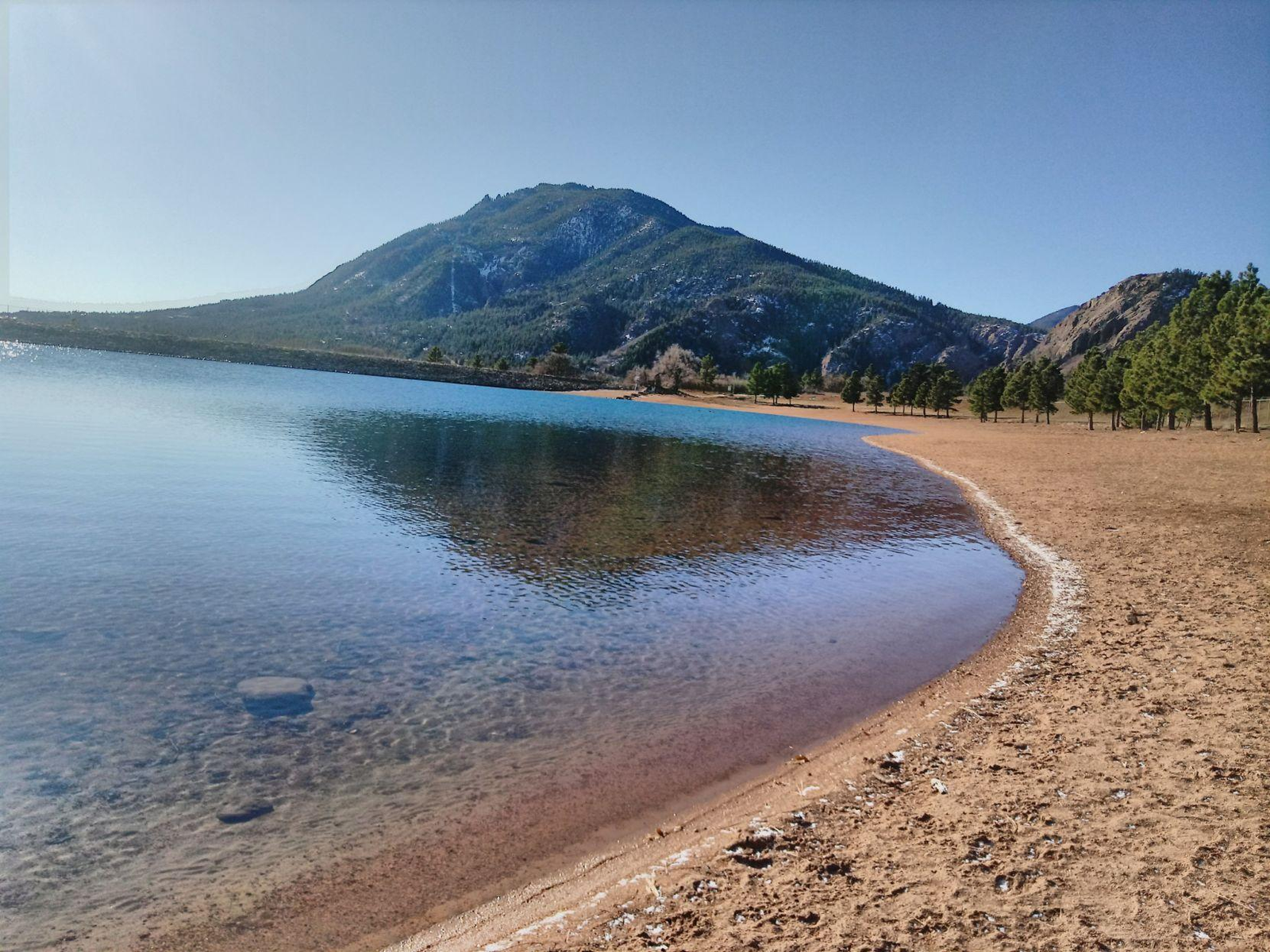
Name and Location: Stratton Open Space covers over 1,500 acres of natural foothills landscape along the sloping western edge of Colorado Springs in the Stratton Preserve neighborhood off West Colorado Avenue.
History and Significance: Acquired by the city beginning in 1994 after prior ranching uses, Stratton Open Space now shields native grassland ecosystems that support wildlife habitats amid recreational trails with superb mountain views.
What to Expect: A network of multi-use dirt trails invites hiking, trail running, mountain biking and horseback riding across the hilly terrain dotted with gulleys and rock formations that frame exceptional vistas of Pikes Peak and the Rampart Range.
Visitor Information: Year-round trail access. Users should prepare accordingly for variable weather and watch for rattlesnakes. Parking off Adrian Rudd Trailhead or main open space entrance.
A former cattle ranch reinvented into open space just outside downtown spanning 766 acres, this park uniquely offers adaptive recreation alongside typical trails with all access infrastructure. Handcyclists, rollerbladers and standard hikers share the path meandering through minted meadows and pine groves before revealing uninterrupted Pikes Peak views from multiple vantage points.
With an easy grade and Mix It Up Loop sans barriers specifically designed for varying abilities, all who venture through the protected foothills sanctuary leave restored.
Rock Ledge Ranch Historic Site

Name and Location: Rock Ledge Ranch Historic Site occupies a section of Palmer Park centered around 1880s-1890s era homestead buildings accessed off 30th Street near the entrance to Garden of the Gods.
History and Significance: The ranch preserves historic sandstone structures associated with early settlement of the region. Now a museum, Rock Ledge Ranch depicts late 19th century life via seasonal exhibits and living history days like candle dipping, quilting and blacksmithing demos.
What to Expect: Self-guided walking tours of the well-kept homestead cabins built by the Galloway family plus scheduled educational activities that showcase rustic period crafts and folkways amid an interpretive garden site.
Visitor Information: Open for tours mid May through early September. Nominal entry fee charged. Seasonal events also held across other areas of scenic Palmer Park.
At this living history museum depicting 1880s-1900s Frontier life, wooded trails tour the heritage homestead while costumed interpreters demonstrate blacksmithing, quilting and old-fashioned games along the way. Special events might highlight Native American or Civil War reenactments too.
But the park’s true treasure is communing with heritage breeds of livestock from Southdown sheep to Coturnix quail during hands-on activities in the Agricultural Heritage Center encouraging connections between people, animals and the land.
Fountain Creek Regional Park
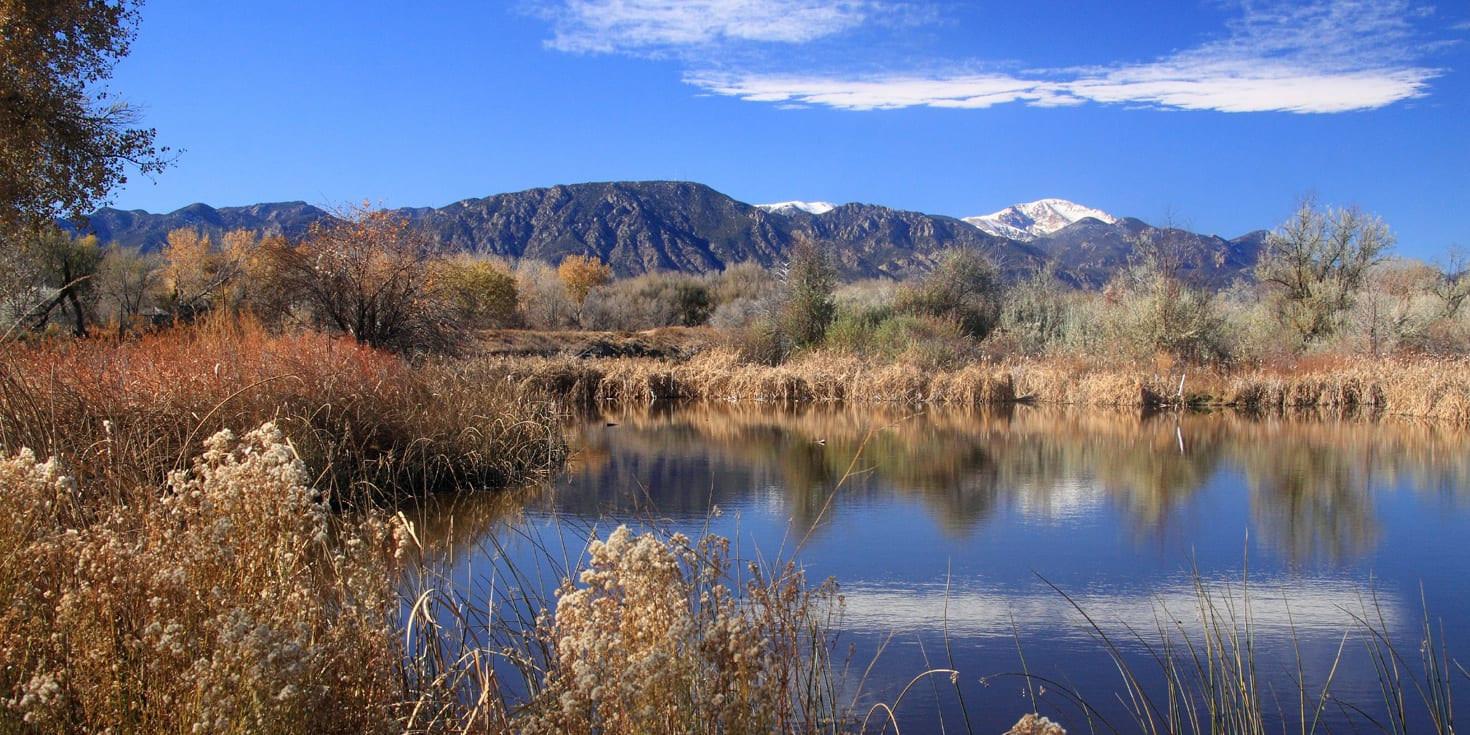
Name and Location: Fountain Creek Regional Open Space spans over 5,000 acres centered on its namesake waterway in southern El Paso County near Fort Carson, Security and Fountain.
History and Significance: Protecting floodplain open space along Fountain Creek that formerly saw agricultural use, this sizable Front Range foothills park system has developed an extensive network of multi-use recreational trails since the land’s public acquisition.
What to Expect: Dozens of miles of dirt trails cater to hiking, trail running, mountain biking and horseback riding across the creek’s riparian corridor enveloped by high plains grasslands and rolling hills facing Pikes Peak revealing enjoyable vistas.
Visitor Information: Year-round trail access. Visitors should note seasons, prepare accordingly and have adequate maps on hand for optimal navigation across the large park system.
Water lovers revel in this rugged 520 acre park centered around glistening Fountain Creek, whose calmer sections invite trout fishing and kayaking or stand up paddleboarding. But on land lovers find delight too with wildlife viewing access and an easy 2.5 mile nature loop traversing wetland boardwalks, bluff trails and wildflower fields.
Don’t miss spying rock squirrels, elk and golden eagles along the way! And hungry hikers appreciate the park’s grills for post-adventure barbecuing.
Fox Run Regional Park
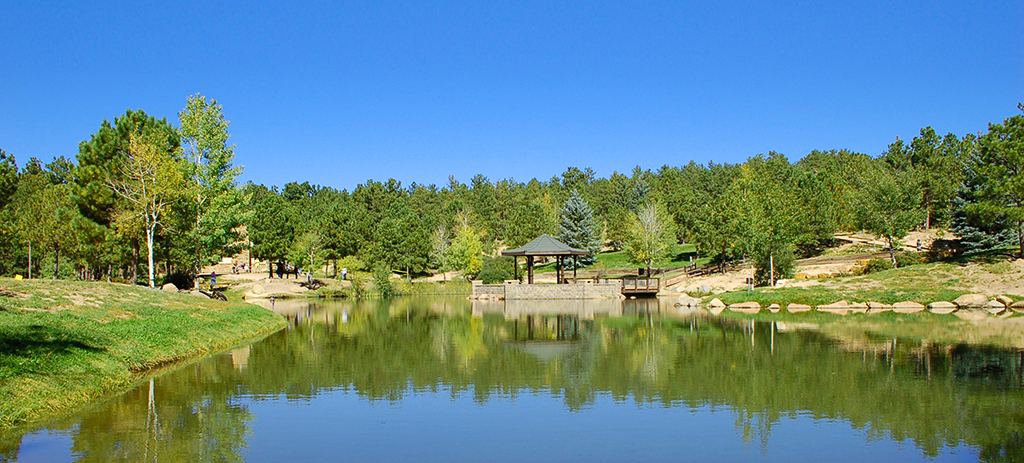
Name and Location: Fox Run Regional Park encompasses 1,347 acres of diverse foothills terrain minutes east of downtown Colorado Springs along the Rock Island Trail reaching Highway 24.
History and Significance: The natural parkland ecosystem once saw mining, ranching and railroad uses before its acquisition by Colorado Springs. Fox Run Regional Park now welcomes visitors to explore pockets of Plains and Foothills ecology via an expanding network of multi-use trails.
What to Expect: Hikers, trail runners and mountain bikers can explore over 15 miles of dirt trail leading through grasslands, ridges and gulches plus a lengthy segment of the Rock Island Rail corridor, with superb scenery present across the park’s varied topography.
Visitor Information: Park open 5am-11pm daily year-round for trail access. Some usage advisories may apply during storm seasons and peak wildlife activity periods like winter. Parking available at main entrances.
Ever dreamed of steering a sailboat across an alpine lake with towering Pikes Peak reflecting in its mirror surface? You can fulfill those fantasies on 325-acre Fox Run Regional Park’s centerpiece reservoir, which allows seasonal boating with paddle craft rentals available.
When not on blue waters, nearly 4 miles of trails like Lakeshore Loop offer stunning vistas and pockets of shade while showcasing unique ecosystems like rare xeric tall prairie grasses. Arrive at dawn or dusk for best wildlife viewing too since deer and foxes frequent.
Monument Valley Park

Name and Location: Monument Valley Park parallels Fountain Creek across over 200 acres inside Colorado Springs from downtown towards the burbs of Roswell and Circle Drive.
History and Significance: Established in 1907 along part of General Palmer’s scenic boulevard, this longstanding central city park provides open green space preserving trees and a portion of Fountain Creek welcoming easy walking paths that connect neighborhoods.
What to Expect: Paved and dirt walking loops catering to pedestrians and cyclists who appreciate the shade trees, Rampart Range vistas and creekside habitat frequented by ducks, geese and other wildlife reside amid this slender urban greenspace oasis.
Visitor Information: Park open 5am-11pm daily for free public access year-round. Restrooms and parking areas available along Monument Valley Park’s length paralleling Fountain Creek on the city’s eastside.
Tracing Monument Creek’s winding channel, this lush 160 acre park delivers over 5 miles of walking paths dotted with towering Cottonwoods, restored wetlands and remnants of 19th century mining operations translating to rich bird habitat. Bring binoculars to spot scarlet tanagers and hummingbirds fueling up in the canopy as you listen to creek waters burbling over stones.
Kayak put-ins along with fishing access allow water-based recreation while athletic fields, playgrounds and an off-leash area keep kids and dogs entertained too.
Conclusion
Whether seeking impressive sandstone formations, reservoirs shining like mountain mirrors or vibrant urban greenspaces, Colorado Springs’ extensive collection of parks capture the region’s natural splendor through landscapes as varied as the activities they invite. Use this roundup as your guide to discover new outdoor favorites indicative of the city’s adventurous spirit.

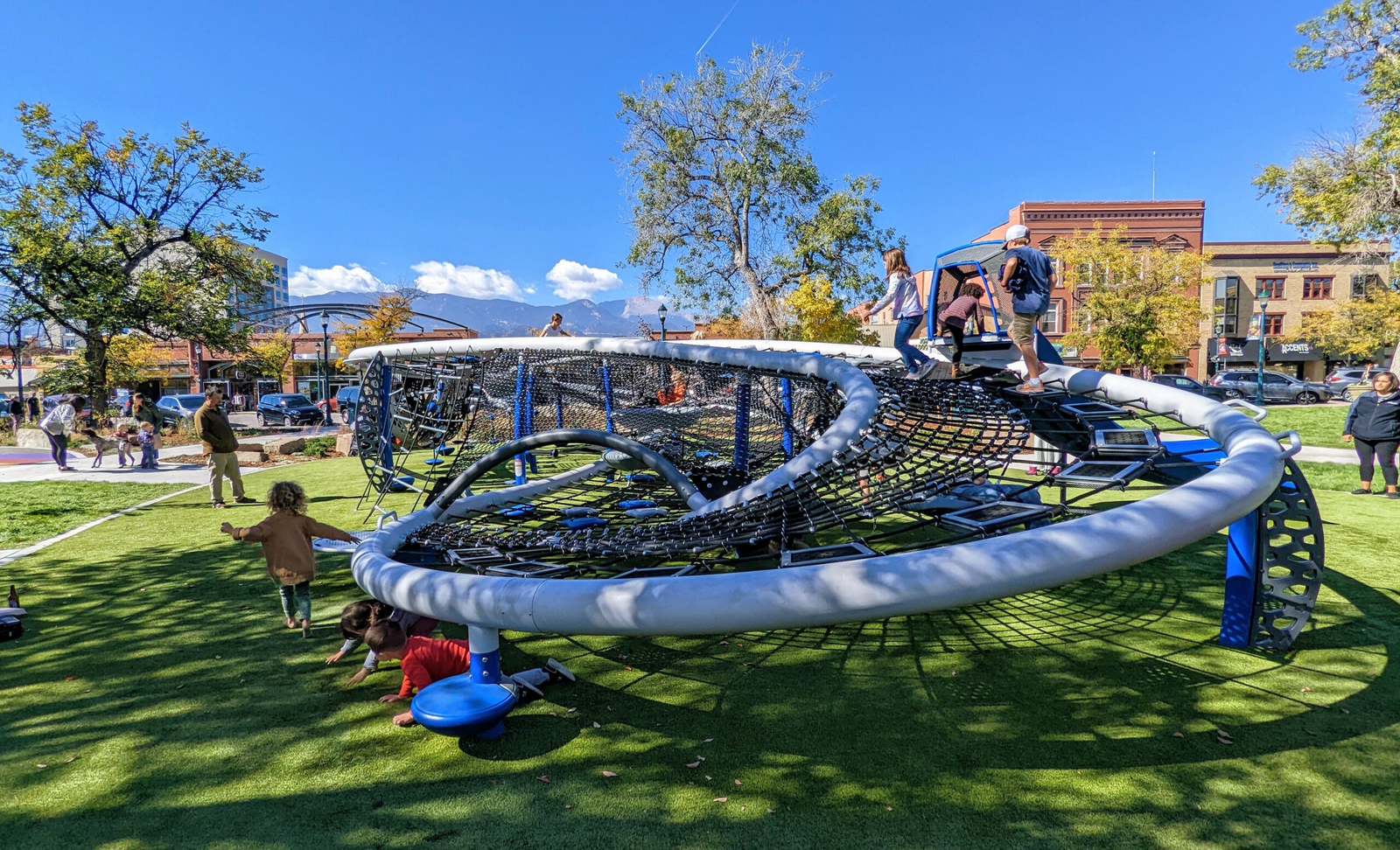



Join the Conversation